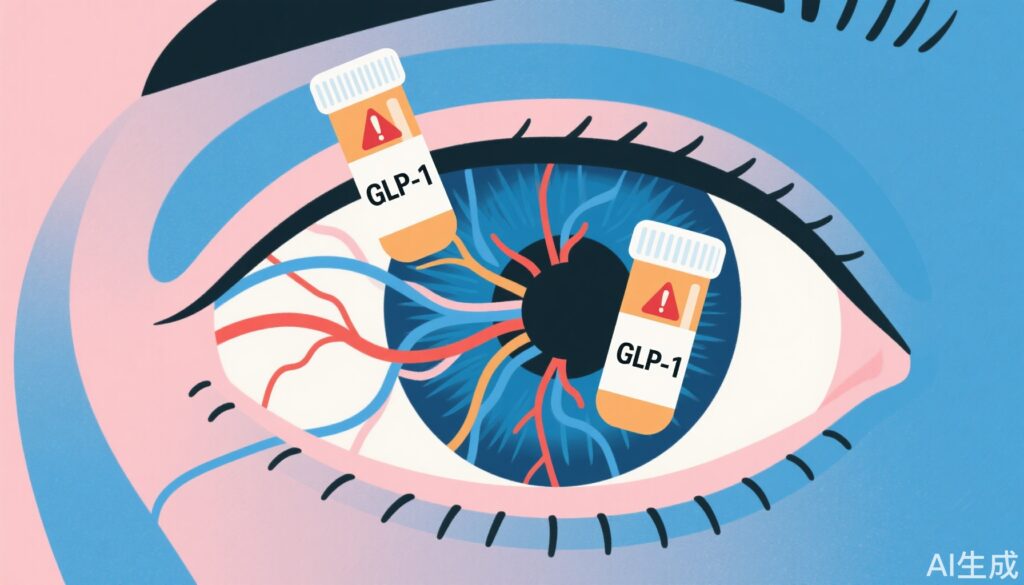Highlight
- Use of GLP-1 receptor agonists, particularly liraglutide, was associated with increased risk of nonarteritic anterior ischemic optic neuropathy (NAION) in the first year of therapy.
- Patients without type 2 diabetes (T2D) or obesity exhibited the highest relative risk when exposed to GLP-1 agents.
- The findings raise new safety considerations for off-label and weight management uses of GLP-1 drugs.
- Further research is needed to clarify mechanisms and refine patient selection.
Background
GLP-1 receptor agonists (GLP-1RAs) have transformed the management of type 2 diabetes and obesity, offering benefits such as glycemic control, cardiovascular risk reduction, and substantial weight loss. Recent years have seen their accelerated adoption, including off-label use in populations without overt metabolic disease. However, as GLP-1RA use broadens, emerging data suggest potential risks that warrant closer scrutiny—among these is the association with nonarteritic anterior ischemic optic neuropathy (NAION), a vision-threatening ocular event.
NAION is the most common acute optic neuropathy in adults over 50 and is associated with vascular risk factors, including diabetes, hypertension, and dyslipidemia. The burden of NAION is not trivial; it often results in permanent visual field deficits and can significantly impair quality of life. Thus, the possibility that widely prescribed metabolic agents could increase NAION risk is of significant clinical and public health concern.
Study Overview and Methodological Design
Nagdeve and Griffin (JAMA Ophthalmol, 2025) conducted a large-scale, retrospective case-control study to assess the association between GLP-1RA exposure and NAION incidence. The study population included 65,612 patients with a diagnosis of NAION, each matched to up to 10 controls (total controls: 641,751) by age, year of insurance enrollment, and T2D/obesity history.
Inclusion criteria encompassed adults with or without T2D or obesity who had sufficient prescription and diagnostic data. Key exposures were defined as ever vs. never use of GLP-1 agents (dulaglutide, liraglutide, semaglutide, exenatide) and categorized by duration (1, 2, or ≥3 years of continuous use). The primary endpoint was new diagnosis of NAION.
Key Findings
GLP-1RA exposure overall was associated with a 19% increase in odds of developing NAION during the first year of use (OR, 1.19; 95% CI, 1.02-1.39). Liraglutide, specifically, carried a higher risk (OR, 1.53; 95% CI, 1.18-1.98). Notably, among individuals without T2D or obesity, the risk was even more pronounced for any GLP-1RA (OR, 2.03; 95% CI, 1.07-3.85) and for liraglutide in particular (OR, 2.32; 95% CI, 1.04-5.20).
Importantly, the risk elevation did not appear to persist beyond the first year of exposure, and the data for other agents (semaglutide, dulaglutide, exenatide) were less conclusive, potentially due to lower case numbers.
| Exposure | All Patients OR (95% CI) | Non-T2D/Obesity OR (95% CI) |
|---|---|---|
| Any GLP-1RA (1st year) | 1.19 (1.02-1.39) | 2.03 (1.07-3.85) |
| Liraglutide (1st year) | 1.53 (1.18-1.98) | 2.32 (1.04-5.20) |
Mechanistic Insights and Pathophysiological Context
The biological rationale linking GLP-1RA therapy to NAION is not fully established. NAION is believed to result from compromised perfusion to the optic nerve head, often in the setting of small vessel disease or nocturnal hypotension. While GLP-1RAs are generally vasoprotective, some preclinical reports suggest complex effects on vascular tone, platelet function, and blood pressure.
It is possible that rapid metabolic changes, volume shifts, or blood pressure reductions associated with GLP-1RA initiation could transiently impair optic nerve perfusion, particularly in predisposed individuals. Alternatively, off-target effects, drug-specific properties (as with liraglutide), or unmeasured confounding (e.g., changes in sleep apnea or nocturnal hypotension) may contribute.
Clinical Implications
For clinicians, these findings underscore the importance of careful risk stratification when initiating GLP-1RA therapy—especially in patients without classic metabolic risk factors, where the relative risk appears highest. While the absolute risk of NAION remains low, the potential for vision loss should prompt informed consent discussions, particularly when prescribing GLP-1RAs for weight management or off-label use.
Ophthalmic evaluation may be warranted in patients with prior NAION, optic disc crowding, or additional vascular risk factors. In cases of sudden visual change, prompt recognition and referral are essential.
Limitations and Controversies
The study’s retrospective, administrative nature introduces possible confounders, such as misclassification of obesity or T2D status, and inability to capture all relevant clinical variables (e.g., optic disc anatomy, sleep apnea, blood pressure profiles). Sample size for certain subgroups, especially non-T2D/obesity patients, was limited, raising the possibility of chance findings or effect size inflation.
Additionally, causality cannot be established, and the observed associations may reflect unmeasured confounding or channeling bias (sicker patients being preferentially prescribed GLP-1RAs). The lack of a clear dose-response relationship also limits mechanistic inference.
Expert Commentary or Guideline Positioning
Current diabetes and obesity guidelines (ADA, AACE) do not specifically address ocular risks with GLP-1RAs. However, this study may prompt future updates, particularly regarding screening and counseling for optic nerve complications. Ophthalmology societies may also consider adding GLP-1RA exposure to risk factor assessments for NAION.
Dr. Emily Walsh, an endocrinologist at the Joslin Diabetes Center (not involved in the study), notes: “While the benefits of GLP-1RAs are substantial, we must remain vigilant for rare but serious adverse events, especially as indications expand. Shared decision-making and close monitoring are key.”
Conclusion
The association between GLP-1RA use and first-year NAION risk—particularly with liraglutide—adds a new dimension to the safety profile of these agents. Although the absolute risk is low, clinicians should be aware of this potential complication, especially in non-diabetic, non-obese patients. Future prospective research is needed to validate these findings, elucidate mechanisms, and refine patient selection strategies.
References
1. Nagdeve P, Griffin R. GLP-1RA Exposure and Nonarteritic Anterior Ischemic Optic Neuropathy Prevalence by Diabetes Status. JAMA Ophthalmol. 2025 Jul 24:e252332. doi: 10.1001/jamaophthalmol.2025.2332.
2. Hayreh SS. Ischemic optic neuropathy. Prog Retin Eye Res. 2009;28(1):34-62.
3. American Diabetes Association. Pharmacologic Approaches to Glycemic Treatment: Standards of Medical Care in Diabetes—2024. Diabetes Care. 2024;47(Suppl 1):S125-S143.



